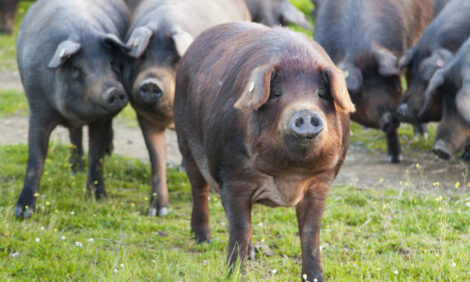



CME: US Hog Slaughter Up
US - Hog slaughter this week was up in the US, whilst cattle slaughter went down, report analysts Steve Meyer and Len Steiner.Weekly Supply Recap: Hog slaughter for the week was 2.290 million head, about 1 per cent higher than the previous week and 6.79 per cent higher than a year ago.
The increase in hog slaughter has been smaller than anticipated and less than implied in the last USDA Hogs and Pigs report. Cash hog prices remain firm, supported by robust gains in the pork cutout, which was up almost 3 per cent compared to the previous week.
All pork items gained ground this week. It is not unusual for ham prices to perform well in October as processors prepare for the upcoming Thanksgiving demand.
What has been a surprise is that belly prices continue to trade very firm and were counter seasonally higher again this week. The pork belly primal was up 4 per cent compared to the week before and 27 per cent higher than a year ago.
We think that strong foodservice demand continues to underpin the belly market at this point. Pork trim remains under pressure given very low prices for beef and chicken trimmings.
Cattle slaughter for the week ending October 10 was 557,000 head, 2.4 per cent lower than a week ago and 1.3 per cent lower than a year ago.
The decline in slaughter has come even as some market participants believe feedlot front end supplies are very heavy and slaughter needs to pick up to clean up the backlog of poorly grading cattle.
We estimate that steer/heifer slaughter last week was 448,000 head, 0.7 per cent lower than last year. Cow and bull slaughter for the week was estimated at 109,000 head, 3.7 per cent larger.
Steer weights for week ending September 26 (two week lag in reporting) were 920 pounds, about 3 pounds lower than the previous week but still about 27 pounds (+3 per cent) higher than a year ago.
It is yet early to pronounce a top in steer weights, normally weights do not peak until November. But this is one indicator that bears watching closely given the impact that very heavy ca?le are having on fed cattle prices.
Export market update: Last week USDA released the official August statistics for US beef, pork and poultry exports.
There was some surprise that pork exports continued to decline in August despite much talk (and speculation) that exports to China were about to explode.
Total US exports of fresh/frozen pork in August were 113,976 MT, 7.6 per cent higher than a year ago but 10.5 per cent lower than in 2012.
Exports of processed pork in August were 15,775 MT, 14 per cent higher than a year ago. At this point pork exports are following a very different trend than what they did in 2012. The lack of strong export demand may cap the upside in the pork export market.
The largest hog slaughter weeks of the year are expected to be in the next 6-8 weeks.
The August pork export data generally tracked well with the weekly export statistics, with one big exception. Exports of fresh/frozen pork to China in August were 9,729 MT, about 3,000 MT lower than July levels. Weekly exports also implied a decline in August but the numbers are vastly off.
Based on weekly statistics, US exports of fresh/frozen muscle cuts to China in July were 5,060 MT compared to a monthly official statistics of 12,887 MT. Weekly export data implied August shipments to China at around 1,976 MT compared to official data putting the total at 9,728 MT.
So the weekly export data captured just a little over 20 per cent of sales in August compared to 40 per cent in July. This is one of the issues one needs to keep in mind when looking at the export data.
They may suggest a direction of trend but there is still quite a bit of variability due to reporting issues.
Beef exports were projected to be very weak based on weekly export statistics and the official August data confirmed that.
Total exports of fresh/frozen and cooked beef in August were 58,941 MT, 23.2 per cent lower than a year ago.
Exports to Asia continue to struggle, with exports to Japan and Hong Kong down 39 per cent and 56 per cent, respectively. Exports to Mexico also remain weak, down 18 per cent in August and down 23 per cent for the year.








